
Lovage (Levisticum officinale) is a hardy perennial herb native to the Mediterranean. As part of the Apiacaea family, it is closely related to carrot, celery, and parsley.
This culinary and medicinal herb was once a common sight in ancient and medieval kitchens and gardens, used in its entirety for its leaves, roots, stems, and seeds.
Its name is derived from “love ache” and was used at one time to concoct love potions and aphrodisiacs.
Although lovage is unfamiliar to most in this current era, it is definitely a great addition to the herbal garden.
Read on to learn more about the lovage plant, how to grow it, and delicious ways to use it in the kitchen.
About Lovage…
A large herbaceous plant that can reach a height of six feet or more each season, lovage emerges from the soil in a basal rosette in spring.
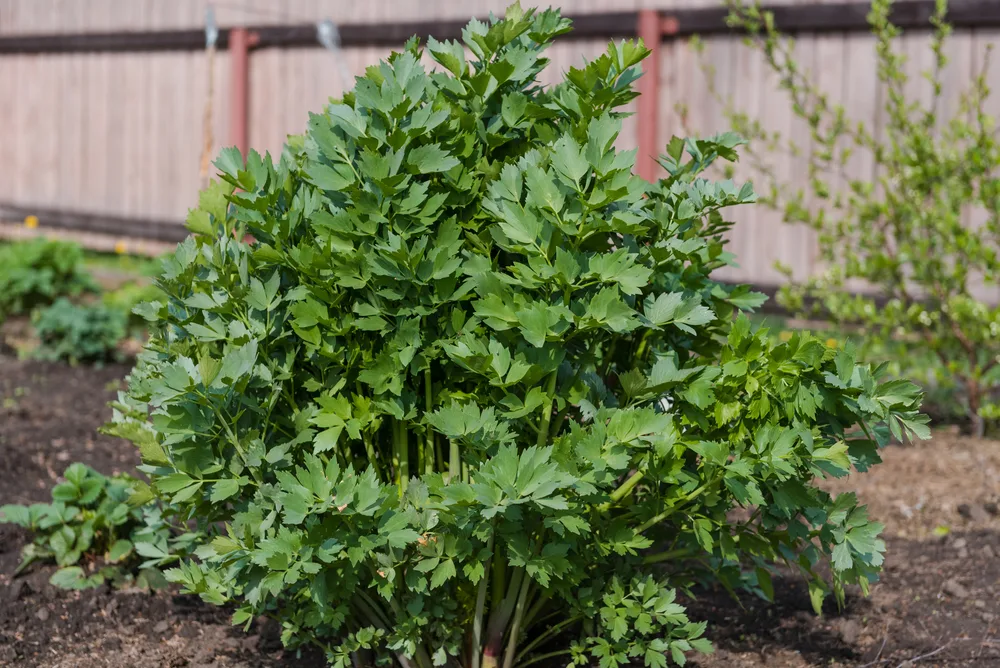
Growing taller and bushier as the season wears on, it develops tripinnate green leaves that are deeply divided and resemble parsley or celery leaves.
Like other members of the umbellifier family, lovage bears multi-branched umbels of tiny yellow flowers in late spring. These globular blooms entice beneficial insects to the garden.
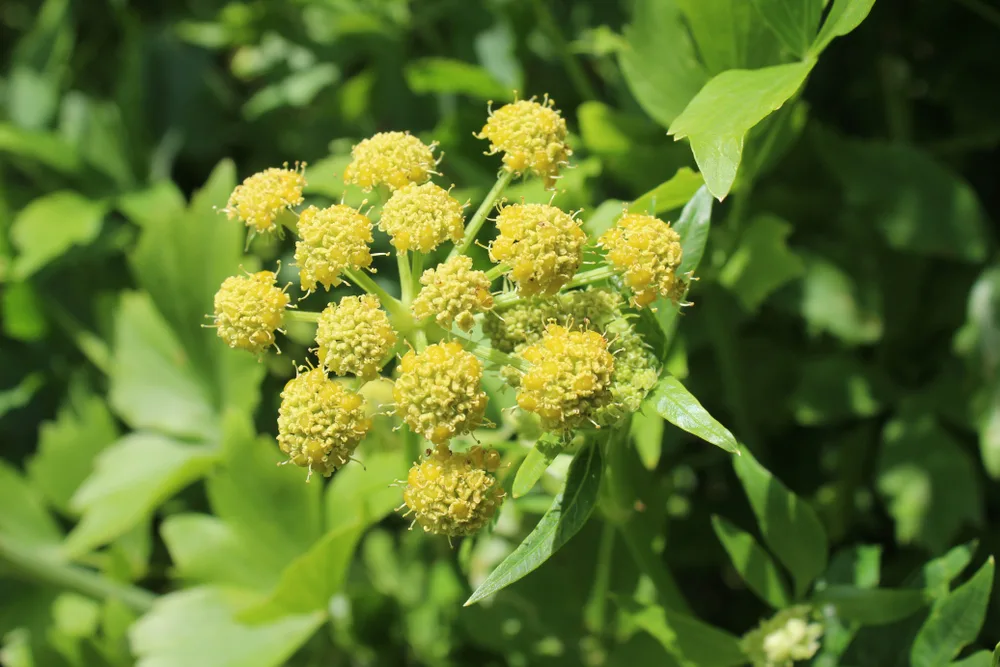
Growing lovage usually means an ample harvest, and all parts of the plant are tasty and edible. The leaves are treated as an herb and used to flavor soups, salads, sauces, and veggies. The stems and roots can be boiled or sautéed as a vegetable, while the fragrant seeds are used as a spice.
Lovage is plenty aromatic, with a flavor that mingles the taste of celery with parsley.
Lovage Growing Conditions:
Hardiness
Lovage is hardy in USDA zones 4 to 8.
Light Requirements
Grow lovage in full sun to part shade. It’s one of the most shade tolerant herbs.
Soil
Lovage will grow best in rich loamy soil that retains moisture well. Prep the herbal bed by adding compost before planting.
Watering
Keep the soil evenly moist. Add mulch to help conserve moisture.
Fertilizer
Give lovage a growth boost by feeding with compost tea a few times throughout the growing season.
Companion Plants
Lovage makes nice with most other garden denizens and is often used to improve the flavor of other nearby plants. Try growing lovage alongside tubers like potatoes, yams, taro, or artichokes.
How to Grow Lovage
From Seed…
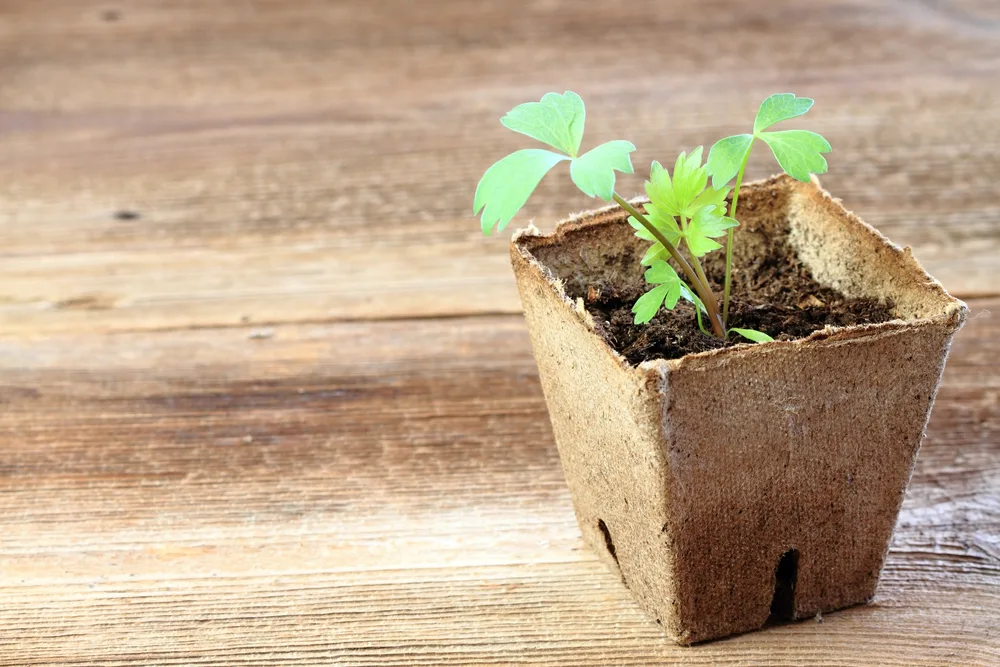
Like celery and parsley, lovage has a long germination period with a preference for cool conditions. To increase germination rates, plant only the freshest seeds and soak them in water for overnight prior to sowing.
- Start lovage seeds indoors 10 to 12 weeks before the last spring frost date for your area.
- Scatter a few seeds in a small pot filled with soil and cover with a thin layer of soil or perlite.
- Keep the soil evenly moist.
- Seeds should germinate in about two weeks.
- When seedlings are about an inch tall, prick them out and plant in individual pots.
- At two inches, seedlings can be hardened off and planted in the garden.
From Starter Plant…
Starting lovage from seed can be hit or miss. Purchase starter plants from your local nursery to save time and effort. Just one or two lovage plants should provide more than enough at harvest time.
- Once all danger of frost has passed and evening temperatures are above 40°F, lovage seedlings can be transplanted to the garden.
- Loosen the soil around your planting site.
- Work some compost into the soil.
- Space plants 2 feet apart, with 2 feet between rows.
- Water deeply and often until plants are well established.
From Division…
Lovage is also easily propagated by division in spring.
- Divide basal rosettes with a shovel, digging deep enough to catch a good amount of roots.
- Place the clump in a container or plastic bag. Try to retain the soil it was growing in.
- Add water before transporting it to your home.
- Plant in the garden and water thoroughly.
How to Harvest Lovage
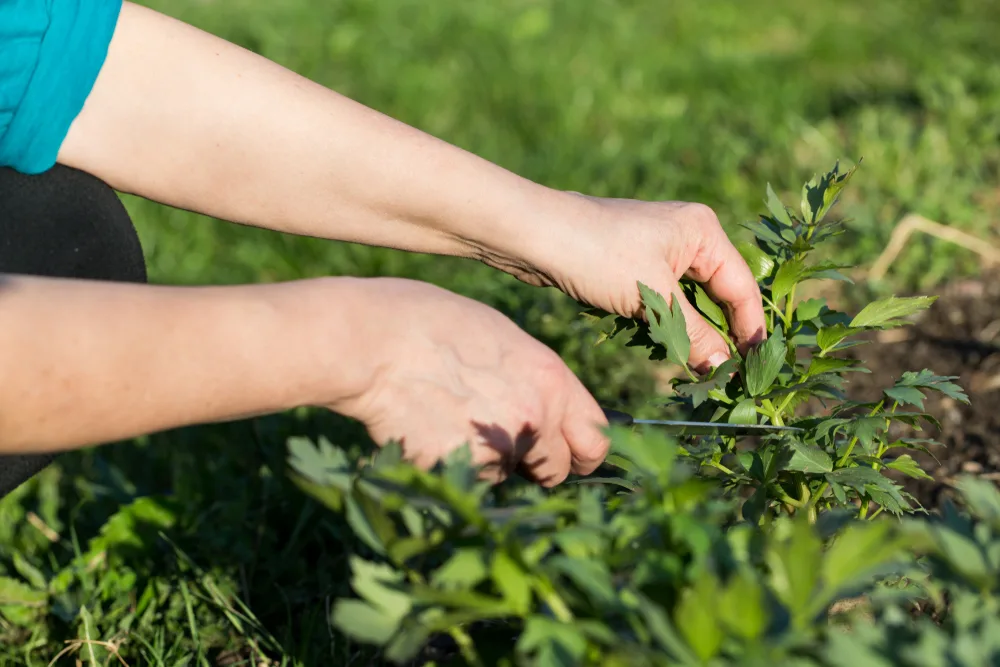
Harvest lovage leaves and stems often throughout the growing season to encourage new growth. Flavor is best when leaves and young and tender, and before the plant begins to flower.
The hollow stalks are harvested by cutting it close to the base of the plant.
Allow lovage to flower to obtain its tasty seeds. Remove seed heads in late summer when dry and brown. Place them in a paper bag and rub between your fingers to release the seeds.

When your lovage plant is 2 to 3 years old, you can start to harvest the roots. Dig up a section of roots with a garden fork before the plant flowers. Wash them well and slice into ½ inch segments. Allow them to dry thoroughly. Lovage roots should be peeled before using.
How to Preserve and Store Lovage
Although lovage is best when used immediately after harvest, there are a number of ways to enjoy them outside of the growing season.
Lovage leaves and stems can be placed in a plastic bag in the fridge to extend their shelf life for a few extra days.
For longer storage, dry lovage sprigs upside down in a warm, dark spot. The quicker you can dry them, the better they will retain their flavor. You may also use the oven or a dehydrator for faster drying times.
Here’s our guide to drying herbs.
Lovage leaves can also be blanched and frozen. Chop them up, place in ice cube trays, add water, and freeze.
Common Issues
Lovage is a pretty robust plant that is rarely troubled by fungus or disease.
Leaf miners can attack lovage foliage, leaving behind the telltale squiggly burrowing lines in the leaves.
Thankfully the damage leaf miners do is mostly cosmetic. Simply remove affected leaves to dispose of the maggots.
Where to Purchase Lovage Seeds
If you can’t find lovage seeds at the garden store, seed packets can be purchased online:
12 Lovage Recipes
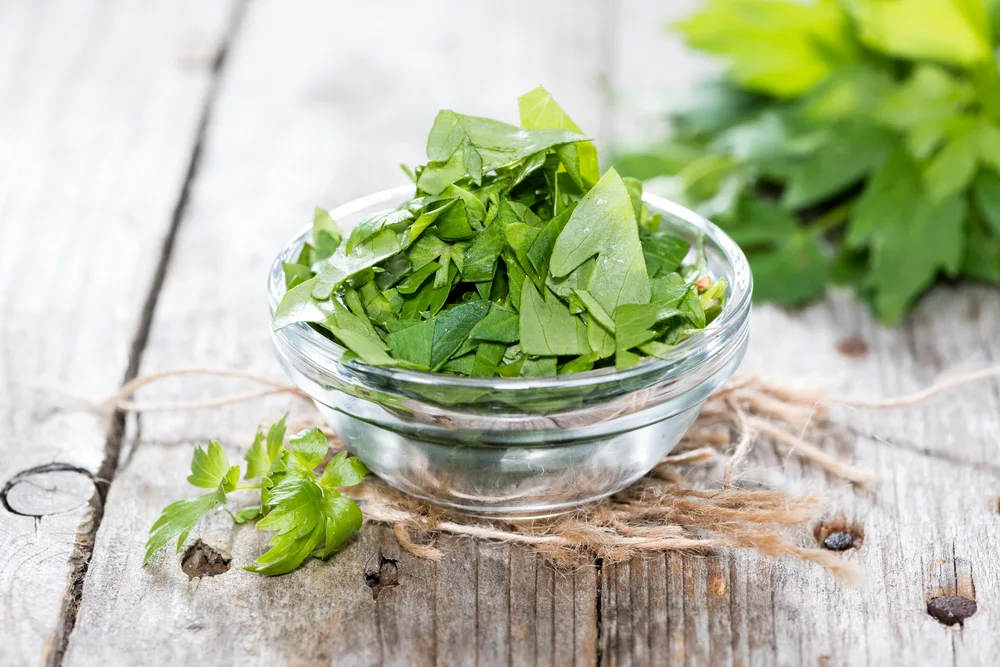
Lovage packs quite a zing – use it whenever you want a fresh, deeply aromatic, and savory punch.
Because lovage is basically a shrub by the end of the season, harvests will be bountiful which allows for plenty of culinary experimentation!
Use it freely as a substitute for recipes that call for celery or celery seed. It is powerful stuff so use a little less when substituting.
1. Lovage Tea
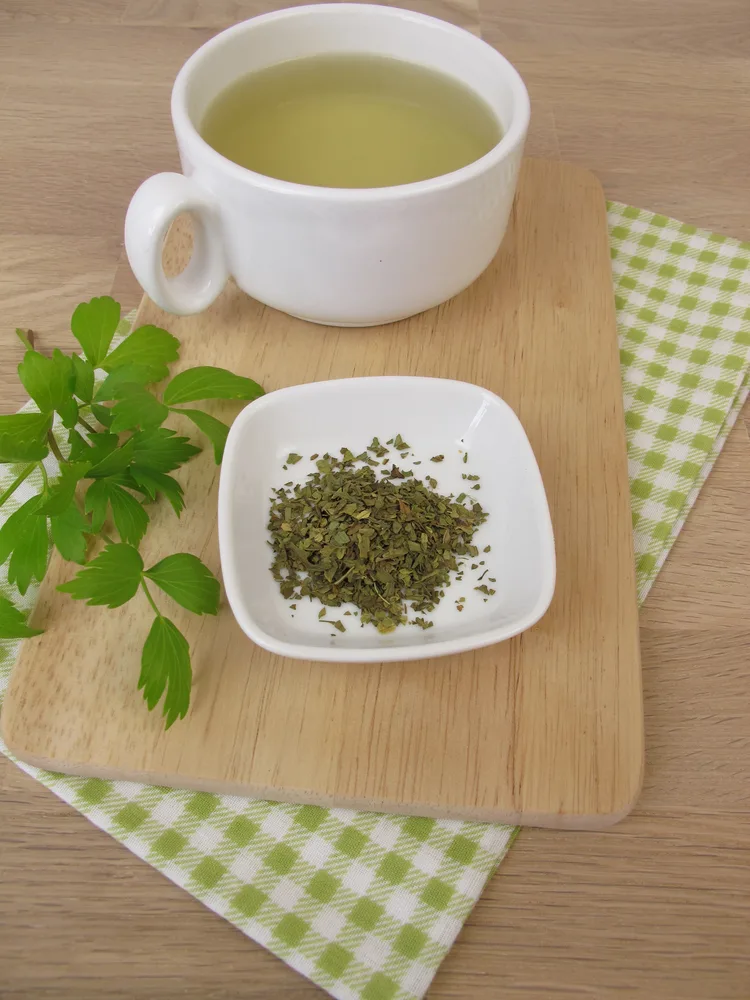
Lovage tea, served hot or iced, is an invigorating beverage indeed!
To make, steep 1 teaspoon of finely chopped lovage leaves or shredded roots in a cup of boiling water for 5 minutes. Strain and enjoy.
2. Sautéed Lovage Stalks
For a quick and easy side dish, the large and hollow lovage stalks can be sautéed much like celery.
Fry up 1-inch lengths of lovage stalks in butter or olive oil, and add a little salt and pepper to season. Ready in just 6 minutes!
3. Creamy Lovage Soup
A lovely soup imbued with the flavors of spring, this recipe includes green onions, yellow onions, russet potatoes, bone broth, and finely chopped lovage leaves.
Get the recipe from Nourished Kitchen.
4. Lovage and Lemon Roasted Chicken
For next level zest, this bone-in chicken recipe is baked on a bed of lovage leaves with thinly sliced lemons and a few more lovage leaves slipped under the chicken skin.
Roasted alongside carrots and onions, it’s a super simple one pot dish.
Get the recipe from Traditional Cooking School.
5. Potato Salad with Lovage
Fresh chopped lovage leaves added to the potato salad mix makes for a bold and intense chilled side dish.
Get the recipe from BBC Food.
6. Apple Lovage Chutney
An aromatic condiment with a long shelf life, this chutney canning recipe will help make sure none of your bumper crops go to waste.
A medley of apples, lovage leaves, red peppers, tomatoes, onions, and garlic, it is sweetened with brown sugar and raisins, and spiced with celery and mustard seed, as well as ginger root.
Get the recipe from RecipeLand.
7. Tomato and Lovage Passata
Tomato passata is an incredibly versatile sauce that can be used on pasta, pizza, rice, and more. Try it as the base for pico de gallo, bruschetta, and tomato juice.
Kick it up a notch with fresh lovage leaves and lovage infused rapeseed oil, which gives this passata a wonderful salty and savory taste.
Get the recipe from British Herb Kitchen.
8. Candied Lovage
Candied lovage (or angelica) stalks are a sweet treat from the days of yore.
To make this 4 ingredient recipe, lovage is repeatedly placed in hot syrup and allowed to cool overnight. This procedure is repeated four times total. As the finishing step, the candied lovage is rolled in granulated sugar.
Candied lovage can be used as a garnish for cakes, cookies, ice cream, and other desserts. It can also be used as a straw for and interesting take on sodas, bloody Marys, or Caesars.
Get the recipe from Honest Food.
9. Lovage Salt
A well rounded seasoning for roasted meats and vegetables, soups, salads, and just about anywhere you might use celery salt.
Combine finely chopped leaves with sea salt in equal parts. Let the mixture sit out in the sun to dry over a few days.
Get the recipe from The Grazer.
10. Lovage Infused Vinegar
Make a more flavorful vinegar by filling a jar about halfway with fresh lovage leaves. Top it off with white, rice, or apple cider vinegar. Seal the jar and put it in a dark spot for 2 weeks. Strain out the bits and store until ready to use.
You can use this concoction when making vinaigrettes and in lieu or plain vinegar in homemade hot and sour soup.
11. Lovage Cordial
This highly stimulating liqueur should definitely get the senses tingling!
A combination of crushed lovage seeds, sugar, vodka, black pepper, and red pepper seeds, let it stew for a month in a sealed container before straining – and imbibing.
Get the recipe from Mother Earth Living.
12. Lovage Soda
Lovage leaves can be rendered into a sweet syrup and topped off with fizzy water. Use a lovage stem as a straw to really rock your world.
Get the recipe from Martha Stewart.

Get the famous Rural Sprout newsletter delivered to your inbox.
Including Sunday musings from our editor, Tracey, as well as “What’s Up Wednesday” our roundup of what’s in season and new article updates and alerts.

